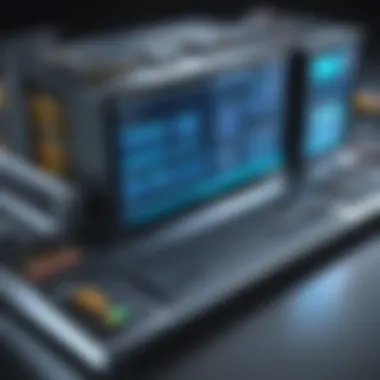Exploring Remote Terminal Units: Functions and Trends


Intro
Remote Terminal Units (RTUs) have positioned themselves as key components in contemporary industrial systems. Their capabilities extend beyond mere data collection; they serve as vital links between remote environments and central monitoring stations, thereby enhancing operational efficiency. This article delves deeply into RTUs, covering their functions, applications across various sectors, and prospective evolutions. As industries increasingly rely on automation and real-time data for decision-making, the understanding of RTUs’ functionalities can no longer be overlooked.
Understanding Storage, Security, or Networking Concepts
Intro to the basics of storage, security, or networking
In the context of RTUs, understanding storage, security, and networking becomes essential for optimized operations. RTUs are fundamentally sophisticated devices capable of collecting and transmitting data. Therefore, the architecture of data storage systems must be efficient, while simultaneously ensuring that the connections are resilient against vulnerabilities. This balance ultimately defines the operational integrity of industrial control systems that use RTUs.
Key terminology and definitions in the field
A familiarity with terms can enhance comprehension:
- Remote Terminal Unit (RTU): A microprocessor-controlled electronic device used in monitoring physical conditions at remote sites.
- Supervisory Control and Data Acquisition (SCADA): A system for remote monitoring and control that integrates RTUs to execute tasks easily.
- Data Communication Protocols: Instructions governing how data is transmitted, such as Modbus or DNP3.
Overview of important concepts and technologies
In RTU applications, several key concepts and technologies become of utmost importance:
- Data Acquisition: The process of collecting data from various physical assets remotely.
- Secure Communications: Implementation of secure connections to prevent unauthorized access.
- Cloud Integration: The capability of RTUs to send data to and receive instructions from the cloud.
Understanding these concepts sets the foundation for further discussions on RTUs and their indelible influence in industrial applications. As organizations increase their automation efforts, knowledge about these technological frameworks enhances both strategic planning and daily operations.
The success of remote terminal units hinges on a combination of robust networking, secure data management, and efficient storage solutions. Without these elements, the reliability of industrial automation remains at risk.
In the next sections, we will explore in detail the functions and applications of RTUs, the challenges they present, and the trends pointing to their future evolution. This approach aims to bolster reader comprehension and engagement with this vital subject matter.
Intro to Remote Terminal Units
Remote Terminal Units (RTUs) play an essential role in the automation and control of various industrial systems. Their importance cannot be overstated as they help industries streamline operations by facilitating real-time monitoring and remote control of equipment. This introduction emphasizes their crucial functions and overarching purpose within automation frameworks, positioning them as an indispensable component in critical sectors like energy, water management, and transportation.
Definition and Purpose
Remote Terminal Units are electronic devices that collect data from sensors and control devices in the field. They serve as an interface between a centralized management system and remote assets, be it remote pipelines, substations, or waterworks. At the core, RTUs play a twofold role: they send back pertinent data to monitoring systems, and allow for the remote management of physical devices. The boundary that they bridge between technology and operations makes them integral to any modern, automated system.
The real purpose here extends beyond merely collecting data. With RTUs, organizations gain insights that enable swift decision-making and proactive maintenance. Increased availability for analyses leads to efficient use of resources and often results in reduced operational costs. Furthermore, they ensure adherence to regulatory guidelines by constantly monitoring systems and generating reports automatedly, lifting much of the manual burden off operators.
Historical Development
The evolution of Remote Terminal Units can be traced back to the early automation needs that arose as industries began adopting more complex processes. Initially tied to basic supervisory control and data acquisition (SCADA) systems, RTUs have undergone significant advancements, especially in terms of technology and capabilities.
In the 1960s and 1970s, the arrival of microprocessors launched a new age, transitioning RTUs from centralized systems to flexible, decentralized entities. This laid the groundwork for their eventual role in Internet of Things (IoT) integrations seen today. The demand for real-time data led to innovations in data processing speeds, such as the incorporation of wireless communication methods that enhanced data transmission efficiency.
Moreover, as investments in infrastructure increased over the years, RTUs built on these technological developments grew more versatile and robust. Early efforts focused on non-scalable devices have now blossomed into multiple, interconnected RTUs that can sync seamlessly within a broader network of equipment. The possibility of remote monitoring and control evolved from a mere convenience to a necessity across various fields. This trajectory paved the way for continued enhancements, making RTUs what they are today: sophisticated gateways of industrial functionality that uphold efficiency and safety standards rampantly across the globe.
Core Functions of Remote Terminal Units
Remote Terminal Units (RTUs) are crucial in today’s industrial landscape, facilitating various core functions that enhance operational efficiency. Understanding these functions provides insights not only into how RTUs contribute to industrial automation but also how they streamline data management and enhance decision-making. Here, we will delve into three primary functions: Data Acquisition, Monitoring and Control, and Communication Protocols.
Data Acquisition
Data acquisition is a fundamental function of RTUs. RTUs gather real-time data from field devices, sensors, and other monitoring equipment. This data plays a key role in how organizations analyze equipment performance, assess conditions, and identify potential issues. Through accurate data collection, RTUs help maintain operational continuity and enhance system reliability.
With the ability to sample data at high frequencies, RTUs minimize the delay between data collection and response, enabling quicker decision-making. Furthermore, the granularity of data collected contributes significantly to predictive maintenance strategies. When data is constantly available, it paves the way for better analytical models and service interventions, as it inform operations teams about the current health of their systems.
Monitoring and Control
Another critical function of RTUs is monitoring and controlling industrial equipment. RTUs provide a structured platform to supervise processes and intervene as required. In situations such as power generation or distribution, the ability of RTUs to automate control processes significantly reduces human error and enhances response times around critical operations.


Vacuumtight integration with supervisory control and data acquisition (SCADA) systems ensures that operators have a coherent view of operational states. Whether triggering alarms in case of abnormal conditions or adjusting outputs from control systems remotely, RTUs enable organizations to maintain highly regulated environments with real-time visibility unlike ever before. Thus, not only do they facilitate oversight and intervention, but they also foster compliance with regulatory standards.
Communication Protocols
To achieve effective functionality, RTUs depend on various communication protocols. These protocols represent the frameworks through which data travels to and from RTUs and connected systems. Key protocols include Modbus, DNP3, and IEC 61850, which enhance interoperability among systems.
Understanding the role of communication protocols is vital. Reliable data transmission and control commands directly affect process dynamics. RTUs, employing these standard protocols enable disparate systems and devices to communicate efficiently, which expands the potential for integrating smart devices and facilitates future enhancements in functionality.
Effective communication ensures that RTUs do not function in isolation but rather integrate seamlessly into larger systems, improving resilience and responsiveness. The evolution of communication methods signals a future where data sharing and equipment operation can be further automated, leading to smarter systems altogether.
Overall, the core functions of RTUs—data acquisition, monitoring and control, and communication protocols—work cohesively to underpin industrial success. While these functionalities are robust on their own, their contribution to collective operations offers an invaluable resource in driving efficiency and effectiveness across sectors.
Key Features of Remote Terminal Units
Remote Terminal Units (RTUs) are critical to the efficiency of industrial automation. Their key features play an important role in optimizing systems and enhancing reliability in operations. The features discussed below—scalability, interoperability, and robustness—are essential for analyzing how RTUs function in diverse environments and across various industries, proving their worth beyond mere technical specifications.
Scalability
Scalability refers to the capacity of a system to grow and adapt to increased demands. In the cue of RTUs, scalability means that as an organization's operations expand, the RTU can also accommodate this change in size and complexity. The modular design of modern RTUs allows for easy integration of additional units or features without significant system disruption.
- Adaptability in Operations: When a new facility is added, or existing systems require upgrade, scalable RTUs mean less friction during implementation.
- Cost Effectiveness: Investing in scalable technology reduces future capital costs. Companies avoid expensive wholesale system overhauls since they can expand incrementally based on operational growth.
- Future-proofing: With expected advancements in technology, having a scalable RTU ensures that businesses can adapt to changes without major investments.
Interoperability
Interoperability is the ability of various systems and organizations to work together seamlessly. For RTUs, this aspect is critical since they often need to collaborate with a variety of devices and software from multiple manufacturers.
Considerations include:
- Standardized Protocols: Utilizing common communication standards enables RTUs to effectively transfer data across diverse platforms.
- Flexibility: RTUs that support multiple protocols minimize the risk of obsolescence. This mitigates cumbersome retrofitting processes and allows the incorporation of contemporary technologies easily.
- Streamlined operations: Through better compatibility with existing systems, organizations can seamlessly manage operations, boosting efficiency.
Robustness and Reliability
Robustness and reliability are inherent characteristics that dictate the lifespan and performance of an RTU. Industrial environments often involve challenging conditions, including extreme temperatures, moisture, and impacts. Consequently, robustness becomes a paramount feature to ensure operational continuity.
- Durable Construction: High-quality materials help meet rigorous industry standards, leading to equipment that can withstand adverse conditions.
- Redundancy Mechanisms: Reliable RTUs often incorporate failover systems, minimizing service interruptions during unexpected failures.
- Regular Firmware Updates: Maintaining reliability also means consistent improvements to software that can address vulnerabilities or enhance performance over time.
“A blend of features such as scalability, interoperability, and robustness determines not just whether a remote terminal unit will perform adequately, but how effectively it will adapt to both current and future industrial needs.”
Understanding these key features will enable industries exploring RTUs to make informed decisions. As technology progresses, appreciating each element ensures systems are efficient, integrated, and capable of weathering industrial demands with durability.
Applications of Remote Terminal Units
Understanding the applications of Remote Terminal Units (RTUs) is crucial for recognizing their impact in various industries. RTUs serve essential roles in collecting, monitoring, and managing data in real-time. Their integration into automation frameworks helps move industries forward by enhancing operational efficiency and safety. Each sector has its unique needs, driving innovation around RTUs. As we explore applications, we highlight their importance, consistencies, and improvisations.
Energy Sector
In the energy sector, Remote Terminal Units are integral for effective monitoring and control. These units help with data acquisition from substations and renewable energy systems, like solar parks or wind farms. By sensing and communicating critical data, RTUs support grid management and operational decision-making.
With utilities transforming towards smart grids, the demands on RTUs have increased:
- Real-Time Monitoring: RTUs provide continual status updates on various metrics—voltage, current, and power levels.
- Fault Detection: These devices play a vital role in identifying outages or anomalies, allowing for quicker recovery and less downtime.
- Load Management: RTUs facilitate load balancing by providing insights into consumption patterns. This minimizes the risk of overload while optimizing resources.
Water and Wastewater Management
Corporations managing water must prioritize reliability, given the critical nature of this resource. Remote Terminal Units enhance operational monitoring in both treatment facilities and distribution systems.
Key functionalities include:
- Flow Monitoring: RTUs measure and manage water flow, which assists in optimally operating pumps and reducing waste.
- Quality Measurement: These systems track water quality, enabling adjustments to treatment processes when conditions shift. This ensures compliance with health standards.
- Event Logging: RTUs store data events, enabling analysis after incidents. This insight aids in understanding operational anomalies for better prevention strategies.


Investing in RTU technology leads to smart water networks that promote sustainability and efficiency.
Transportation and Smart Cities
Smart cities leverage Remote Terminal Units to improve transportation systems. RTUs contribute to the network’s efficiency, providing data that aids in congestion management and infrastructure maintenance.
Aspects of RTUs in this space include:
- Traffic Monitoring: RTUs collect real-time traffic data, informing control systems to adjust signals or provide notifications to drivers, reducing congestion and travel times.
- Public Transportation Integration: These systems enhance the experience of users by providing updates on public transport schedules, delays, or disruptions via various platforms.
- Infrastructure Health Monitoring: RTUs can assess the status of roads or bridges, indicating when maintenance is needed before issues become critical.
The seaming together of technology and infrastructure opens new avenues for improved urban management. This fosters denser, smarter urban areas focused on sustainability and efficiency.
“RTUs enhance control significantly, minimizing downtime and allowing prompt responses across various applications.”
Utilizing RTUs is becoming a necessity across sectors—energy, water, and transportation. Their multifaceted applications indicate a transformative impact, optimizing operations and reinforcing the modern industry's backbone through advanced, real-time capabilities.
Challenges in Implementing Remote Terminal Units
Integrating Remote Terminal Units (RTUs) into various industrial frameworks presents numerous challenges, making the understanding of these obstacles crucial for industry professionals. RTUs offer significant benefits, including improved data collection and remote management of systems. However, this transformation isn't without difficulties, which include integration issues, security concerns, and cost considerations.
Integration with Legacy Systems
One of the most prominent challenges in implementing RTUs is their integration with legacy systems. Many organizations rely on established technologies that are deeply woven into their operational processes. Incorporating RTUs into these outdated systems demands thorough planning and execution. Compatibility issues can arise because older systems might not support modern communication protocols of RTUs. Often, customization of RTUs is necessary to function seamlessly with existing infrastructure.
Integrating new technology while maintaining older systems can incur high costs and extended implementation timelines.
- Limited Functionality: Legacy systems may lack features that RTUs need, hindering overall performance.
- High Maintenance: Facilities may require continual updates for both RTUs and legacy systems, complicating settings further.
- Vendor Lock-In: Organizations may become dependent on specific vendors for parts, support, and upgrades.
In practice, a careful evaluation of the current infrastructure is necessary to forge a pathway for successful integration without compromising operational stability.
Cybersecurity Risks
Using RTUs in industrial contexts also introduces critical cybersecurity risks. These units frequently connect to broader networks, making them potential targets for security breaches. Smart technologies such as RTUs are attractive targets for cyber attacks, which can result in data theft, service disruptions, or even dangerous malfunctions.
Several factors sharpen the focus on cybersecurity:
- Insufficient Protection: Existing security measures may not be adequate to address the complexities of RTU operations.
- Network Vulnerabilities: Attackers may exploit entry points created through RTU connections, allowing unauthorized access.
- Regulatory Pressures: Continuous changes in cybersecurity regulations can pressure organizations to rapidly adapt and update their systems.
An organization must develop comprehensive risk management strategies to assess these threats and implement necessary safeguards, ensuring both data security and operational efficiency.
Cost Implications
Lastly, discussing the cost implications is essential when examining the adoption of RTUs. The preliminary investment is often substantial, influenced by numerous factors, such as technology costs, training staff, and potential retrofit of existing systems. Economic strain is not merely an upfront burden; ongoing operational costs can accumulate significantly.
Considerations include:
- Infrastructure Overhauls: Bringing RTUs into operation can necessitate extensive infrastructure upgrades, amplifying costs.
- Talent Acquisition: Hiring specialists for installation and ongoing operations can further inflate financial projections.
- Long-term Value: While the political cost is visible immediately, measuring return on investment may take time, impacting short-term budgeting decisions.
Technological Advancements in Remote Terminal Units
Technological advancements play a crucial role in the evolution of remote terminal units (RTUs). These developments are not just enhancements; they fundamentally transform how RTUs operate and increase their effectiveness across various sectors. Key advancements such as the Internet of Things (IoT), artificial intelligence, machine learning, and cloud computing make RTUs more responsive, powerful, and integral to modern industrial systems.
The Internet of Things (IoT)
The Internet of Things has revolutionized the operational paradigm of RTUs. With IoT, RTUs are no longer isolated entities. They connect to various devices, allowing data exchange in real-time. This interconnectivity leads to improved monitoring and control.
Some of the important benefits of IoT integration include:
- Improved Data Collection: IoT-enabled RTUs can gather data from multiple sensors across a network. This provides detailed insight into system performance.
- Remote Monitoring: Operators can monitor processes from any location, increasing responsiveness and reducing downtime.
- Predictive Maintenance: Anticipating equipment failure becomes possible through continuous data analysis.


IoT certainly enhances the efficiency of RTUs. However, it also brings challenges, such as ensuring cybersecurity to safeguard sensitive data.
Artificial Intelligence and Machine Learning
Artificial Intelligence (AI) and Machine Learning (ML) technologies are also significantly impacting the functionality of RTUs. These technologies improve decision-making capabilities. By analyzing data patterns, RTUs can autonomously adjust operations in real-time.
Some benefits of incorporating AI and ML are:
- Enhanced Decision Making: RTUs can analyze complex data for improved operational decisions.
- Anomaly Detection: Identifying irregularities in system performance can reduce the risk of faults.
- Self-Optimization: Over time, RTUs can learn from historical data, thus increasing their efficiency autonomously.
Despite these advantages, the integration of AI and ML should be approached cautiously to address the ethical considerations of machine learning and its implications on employment.
Cloud Computing Integration
Cloud computing has transformed how RTUs function within broader ecosystems. By leveraging the power of cloud platforms, RTUs can store, process, and analyze vast amounts of data remotely.
The benefits of cloud computing integration include:
- Scalable Storage Solutions: As businesses grow, cloud services enable them to scale RTU capabilities without extensive infrastructure investment.
- Data Sharing: Teams across different locations can access shared data in real-time, optimizing collaboration.
- Cost Efficiency: Businesses can reduce operational costs by utilizing cloud-based solutions instead of on-premise hardware.
However, reliance on cloud services necessitates a robust cybersecurity strategy to prevent unauthorized access to sensitive data.
In summary, the technological advancements in remote terminal units are shaping the future of industrial monitoring and control systems. IoT, AI, ML, and cloud computing provide versatile solutions to typical challenges, paving the path for smarter and more efficient operations across industries.
Future Trends in Remote Terminal Units
The future of remote terminal units (RTUs) incorporates several transformative trends that are essential for advancing operational efficiency in industrial monitoring and control systems. In a rapidly evolving landscape, these trends not only enhance the functionality of RTUs but also define their integration within larger automation contexts.
Increased Automation
One significant trend driving the future of remote terminal units is increased automation. This advancement allows for streamlined operations within harsh environments. RTUs can now be integrated with automated systems that reduce the need for human intervention. This decrease in manual tasks leads to enhanced reliability and accuracy in data collection. Automated systems can handle repetitive functions with speed and precision.
Moreover, automated RTUs are capable of self-diagnosis. This self-assessment leads to reduced downtime, as they can quickly report failures. Businesses will benefit through cost savings as they can predict and prevent system breakdowns before they affect productivity.
Enhanced Data Analytics
Another emerging trend is the emphasis on enhanced data analytics. Organizations continuously collect vast amounts of data through their RTUs. The ability to analyze this data effectively is invaluable. With advanced analytical tools, RTUs can transform raw data into actionable insights. This leads to improved decision-making patterns across various sectors, including energy and transportation.
For example, predictive analytics is now integrated into RTU systems. This means that companies can forecast potential failures, optimize asset performance, and enhance maintenance schedules. By investing in effective data analytics, organizations can harness the full potential of their RTUs, leading to operational efficiency improvements.
Sustainability Considerations
Lastly, sustainability considerations are becoming a prominent trend in the development of remote terminal units. Environmental awareness is on the rise, pushing organizations to evaluate their energy usage and emissions. RTUs can adapt to this shift by implementing energy-efficient processes and optimizing resource usage.
Sustainable practices like solar-powered RTUs are entering the marketplace, enabling operations in remote areas without reliance on traditional energy sources. Moreover, developers are focusing on systems that minimize environmental footprints. This interest ensures that RTUs contribute not only to operational efficiency but also to sustainable industrial functions.
Innovation driven by sustainability will significantly shape RTU design and functionality. Companies that prioritize sustainable solutions will likely retain a competitive edge in the industry.
As the landscape of remote terminal technology continues to evolve, these trends will pave the way for innovative application and development in coming years. Understanding these factors is critical for stakeholders aiming to leverage RTUs effectively.
Finale
The significance of the conclusion section in this article lies in its capacity to encapsulate the critical findings regarding Remote Terminal Units (RTUs). A sophisticated understanding of RTUs emerges not just from acknowledging their critical role in automation but also from recognizing the profound impact they have on various industrial applications. Evaluating the information discussed throughout the article highlights several key elements worth consideration.
Summary of Key Insights
- Core Functions: RTUs serve various functions such as data acquisition, monitoring, and control. Their real-time capabilities are essential for ensuring operational efficiency and safety in industrial settings.
- Technological Integration: The advent of technologies like Internet of Things (IoT) and cloud computing has revolutionized the functionality of RTUs, allowing for enhanced interoperability and scalable solutions.
- Future Directions: Emerging trends indicate a strong movement towards increased automation and sustainability. Furthermore, data analytics capabilities are vital for providing actionable insights within diverse industries.
The rise of cybersecurity threats necessitates robust measures throughout RTU implementation.
- Cross-Industry Applications: The utilization of RTUs spans across many sectors including energy, water management, and transportation. Their adaptability to various contexts speaks to their critical role in modern infrastructure.
- Challenges in Adoption: Despite their advantages, RTUs face significant challenges such as integration with legacy systems and addressing cybersecurity risks. Industry stakeholders must navigate these hurdles to harness the full potential of RTUs.
Final Thoughts on RTUs
In summary, Remote Terminal Units embody a fundamental component of industrial automation. Their enhanced functionalities through technological advances are setting the stage for streamlined operations. Understanding the use and implementation challenges of RTUs is key for IT professionals and cybersecurity experts alike. It will directly impact their future efficacy as enterprises push for digital transformation strategies. Recognizing this critical intersection will help them define a more secure and efficient future, where RTUs are positioned as facilitators of enhanced operational intelligence.
As industries continue to evolve, RTUs will undeniably find themselves at the forefront, driving innovations and improving overall infrastructure resilience in an increasingly digital landscape.



